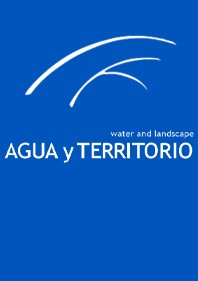
La revista Agua y Territorio / Water and Landscape (AYT / WAL) es una publicación digital, de carácter semestral, de acceso libre, cuyo objetivo es abordar desde diferentes ámbitos científicos la problemática del uso y gestión del agua y su empleo para un desarrollo sostenible. En concreto, cubre las siguientes temáticas:
a) Políticas públicas y participación ciudadana. Una gestión correcta del agua se configura como el principal instrumento para solucionar los problemas de abastecimiento y saneamiento del agua en la sociedad actual. En este ámbito, la participación social y de los movimientos ciudadanos se intuye como el elemento capaz de contrarrestar los conflictos ambientales y sociales que surgen en torno al agua. También ocupa un lugar importante en esta línea de investigación el estudio de las empresas de agua, su evolución y la valoración de sus niveles de fracaso y éxito.
b) El agua como recurso natural: modelos de desarrollo y medio ambiente. El acelerado desarrollo industrial, urbano y demográfico de los dos últimos siglos ha supuesto un importante reto para preservar la calidad del agua y el de sus entornos naturales. Asimismo, se ha debido hacer frente también al gran problema que supone abastecer de agua potable a una población cada vez más numerosa y contrarrestar las potencialidades contaminantes de las aguas servidas.
c) Agua y paisaje. El agua ha ido configurando el acontecer humano desde tiempos prehistóricos y ha ido también modelando el paisaje rural de una forma característica. Los paisajes del agua son un claro ejemplo de las múltiples facetas que entraña el agua como configuradora de territorios en los que se han desarrollado culturas que han dejado su impronta paisajística.
d) Agua y memoria. A lo largo de las relaciones históricas que han tenido los humanos con el agua, ésta ha marcado la memoria de muchas generaciones que han elaborado una cultura peculiar asociada a ella: fuentes, canales, acequias, creencias, festividades, entre otras muchas manifestaciones, han constituido el rico patrimonio material e inmaterial que las sociedades han ido dejando a las generaciones actuales. En este ámbito, es relevante poder recoger los testimonios de la generación que ha vivido el fin de todo el sistema de abastecimiento clásico del agua siendo testigo del surgimiento de los modernos sistemas de abastecimiento y saneamiento.
e) Agua y salud. El agua ha sido un elemento íntimamente unido a las cuestiones sanitarias desde que muchos grupos humanos se asentaran cerca de los cursos fluviales o manantiales. Desde entonces, la calidad del agua en los entornos humanos ha sido un claro síntoma de la calidad de vida que les caracterizaba.
f) Patrimonio hidráulico. La importancia del agua para el mantenimiento de la vida ha motivado que la humanidad tratara de resolver desde la antigüedad múltiples retos como el modo de obtenerla, almacenarla, transportarla…, dando lugar a un rico y variado patrimonio material, pero también a múltiples formas de patrimonio intangible vinculado al agua y a su forma de utilización y gestión.
The journal Agua y Territorio / Water and Landscape (AYT / WAL) is a digital publication, of a biannual nature, with free access, whose objective is to address from different scientific fields the problem of the use and management of water and its use for sustainable development. In particular, it covers the following topics:
a) Public policies and citizen participation. Proper water management is the main tool for solving water supply and sanitation problems in today’s society. In this area, the social participation and citizen movements are perceived as the element capable of countering the environmental and social conflicts that arise around water. The study of water companies, their evolution and the assessment of their levels of failure and success also occupy an important place in this line of research.
b) Water as a natural resource: development and environmental models. The accelerated industrial, urban and demographic development of the past two centuries has been a major challenge in preserving the quality of water and its natural environments. It has also had to deal with the major problem of supplying drinking water to a growing population and counteracting the polluting potential of water.
c) Water and landscape. Water has shaped human events since prehistoric times and has also shaped the rural landscape in a characteristic way. Water landscapes are a clear example of the multiple facets of water as a configurator of territories in which cultures that have left their mark on the landscape have developed.
d) Water and memory. Throughout the historical relations that humans have had with water, it has marked the memory of many generations that have elaborated a peculiar culture associated with it: fountains, canals, ditches, beliefs, festivities, among many other manifestations, have constituted the rich material and immaterial heritage that societies have left to present generations. In this area, it is important to be able to gather the testimonies of the generation that has experienced the end of the whole system of classic water supply, witnessing the emergence of modern systems of supply and sanitation.
e) Water and health. Water has been intimately linked to health issues since many human groups settled near rivers or springs. Since then, the quality of water in human environments has been a clear symptom of the quality of life that characterized them.
f) Water resources. The importance of water for the maintenance of life has motivated humanity to try to solve since ancient times multiple challenges such as how to obtain it, store it, transport it... , giving rise to a rich and varied material heritage, but also to multiple forms of intangible heritage linked to water and its way of use and management.